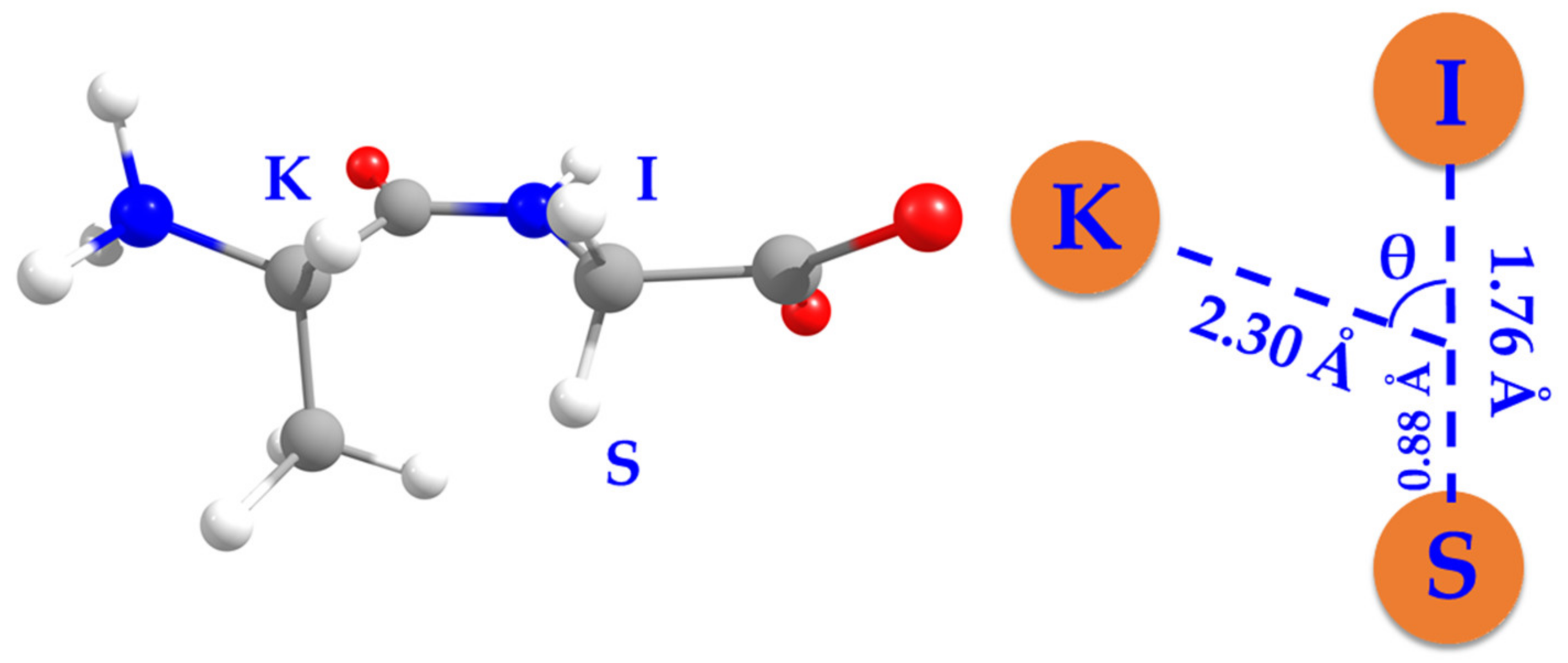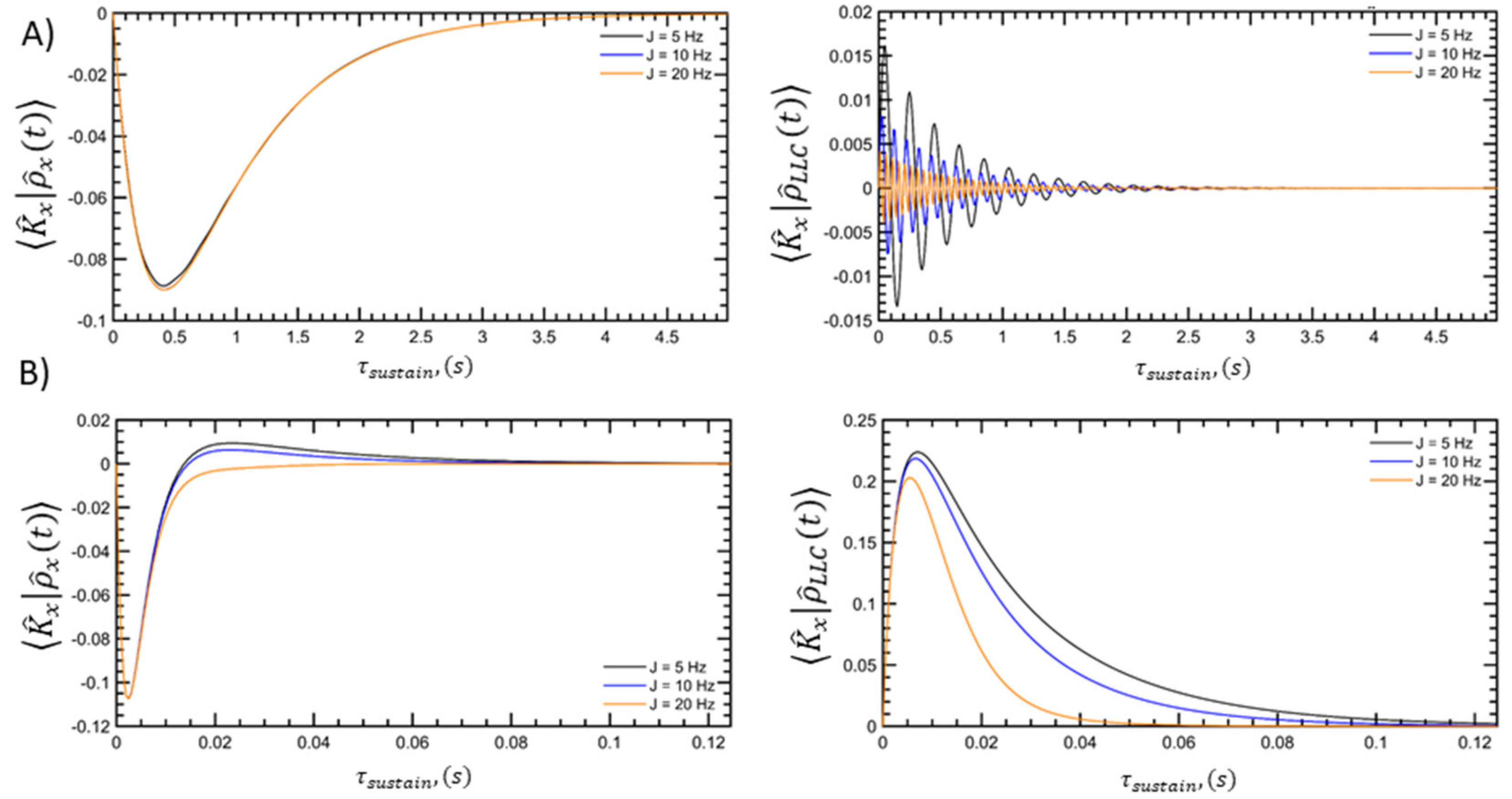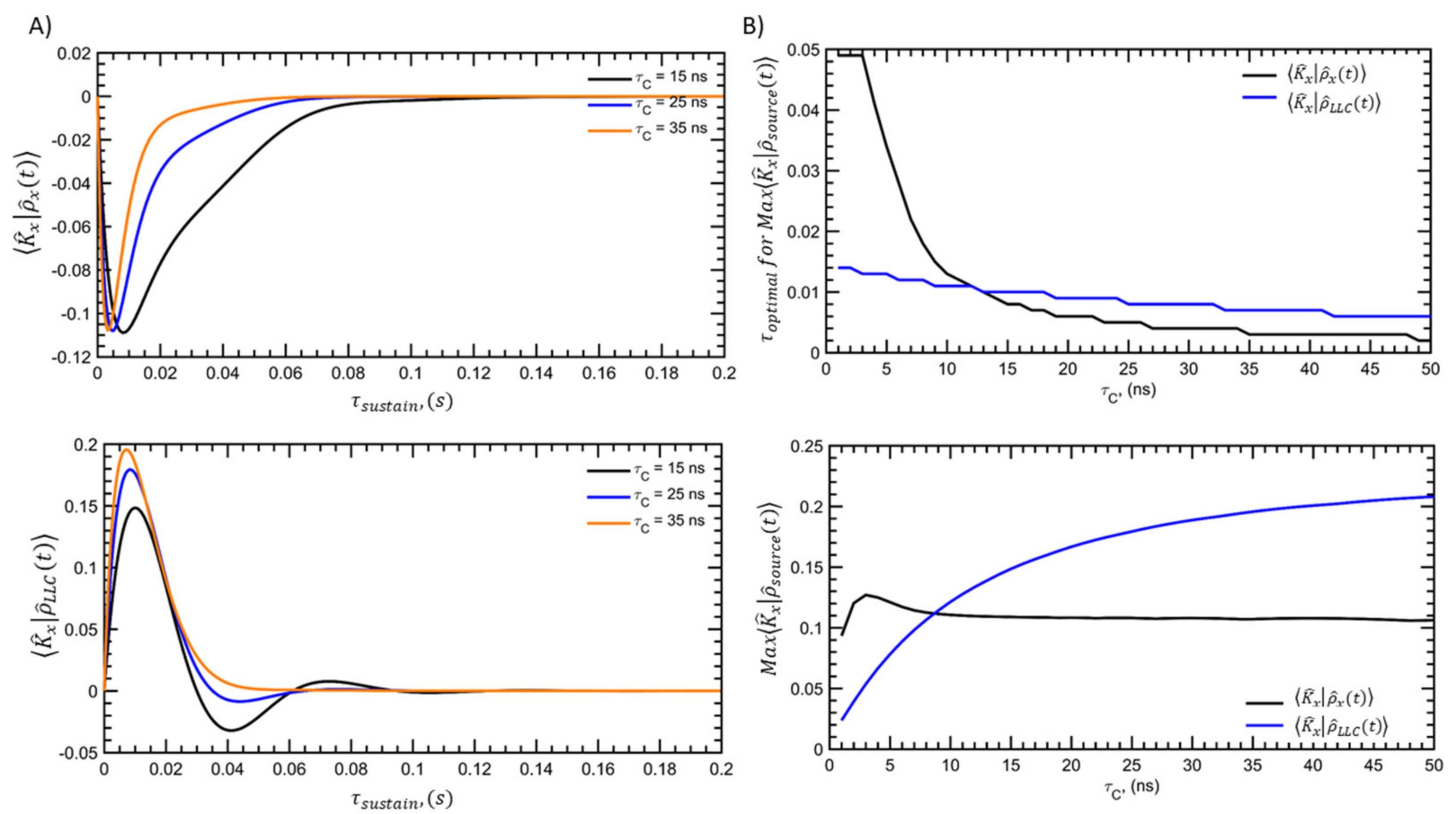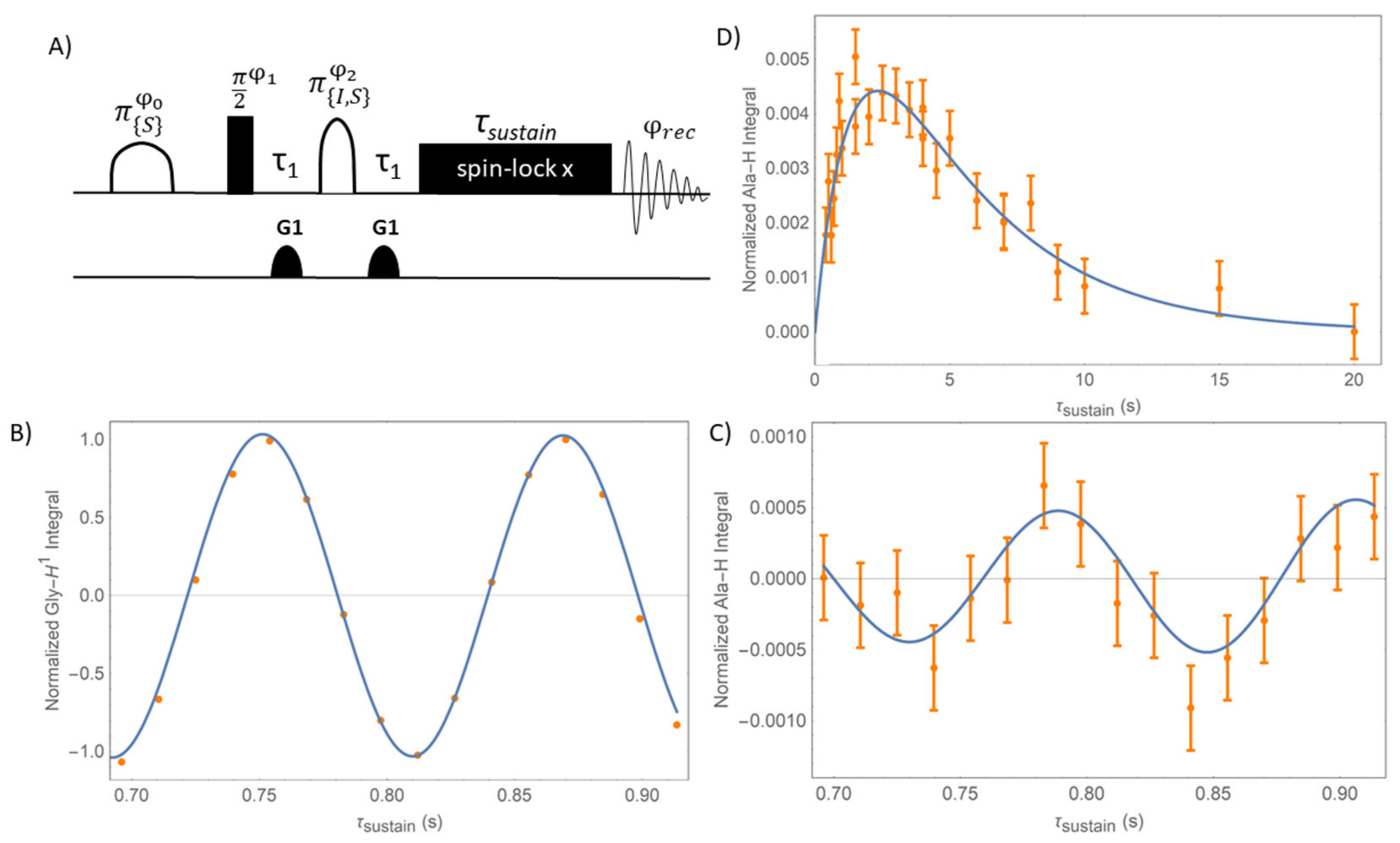Rotating-Frame Overhauser Transfer via Long-Lived Coherences †
Abstract
:1. Introduction
2. Materials and Methods
3. Results
3.1. Rotating-Frame Overhauser Transfer in Different Rotational Tumbling Regimes
3.2. Analytical Derivation of the Evolution of Magnetization Components
3.3. Modulation Induced by the J-Coupling Constant
3.4. LLC-ROE in the Slow-Tumbling Regime
3.5. Experimental Evidence for the Oscillating ROE Transfer Starting from LLC
4. Conclusions
Supplementary Materials
Author Contributions
Funding
Data Availability Statement
Acknowledgments
Conflicts of Interest
References
- Kumar, A.; Ernst, R.R.; Wüthrich, K. A two-dimensional nuclear Overhauser enhancement (2D NOE) experiment for the elucidation of complete proton-proton cross-relaxation networks in biological macromolecules. Biochem. Biophys. Res. Commun. 1980, 95, 1–6. [Google Scholar] [CrossRef]
- Aue, W.P.; Bartholdi, E.; Ernst, R.R. Two-dimensional spectroscopy. Application to nuclear magnetic resonance. J. Chem. Phys. 1976, 64, 2229–2246. [Google Scholar] [CrossRef] [Green Version]
- Marion, D.; Kay, L.E.; Sparks, S.W.; Torchia, D.A.; Bax, A. Three-dimensional heteronuclear NMR of nitrogen-15 labeled proteins. J. Am. Chem. Soc. 1989, 111, 1515–1517. [Google Scholar] [CrossRef]
- Bothner-By, A.A.; Stephens, R.L.; Lee, J.; Warren, C.D.; Jeanloz, R.W. Structure determination of a tetrasaccharide: Transient nuclear Overhauser effects in the rotating frame. J. Am. Chem. Soc. 1984, 106, 811–813. [Google Scholar] [CrossRef]
- Cavanagh, J.; Fairbrother, W.J.; Palmer, A.G., III; Skelton, N.J. Protein NMR Spectroscopy: Principles and Practice; Elsevier: Amsterdam, The Netherlands, 1995; ISBN 978-0-08-051529-8. [Google Scholar]
- Goldman, M. Formal Theory of Spin–Lattice Relaxation. J. Magn. Reson. 2001, 149, 160–187. [Google Scholar] [CrossRef] [PubMed]
- Redfield, A.G. The theory of relaxation processes. In Advances in Magnetic and Optical Resonance; Waugh, J.S., Ed.; Academic Press: Cambridge, MA, USA, 1965; Volume 1, pp. 1–32. [Google Scholar]
- Wangsness, R.K.; Bloch, F. The Dynamical Theory of Nuclear Induction. Phys. Rev. 1953, 89, 728–739. [Google Scholar] [CrossRef]
- Vögeli, B. The nuclear Overhauser effect from a quantitative perspective. Prog. Nucl. Magn. Reson. Spectrosc. 2014, 78, 1–46. [Google Scholar] [CrossRef] [PubMed] [Green Version]
- Bertini, I.; Luchinat, C.; Parigi, G. Solution NMR of Paramagnetic Molecules: Applications to Metallobiomolecules and Models; Elsevier: Amsterdam, The Netherlands, 2001; ISBN 978-0-08-054148-8. [Google Scholar]
- Carravetta, M.; Johannessen, O.G.; Levitt, M.H. Beyond the T1 Limit: Singlet Nuclear Spin States in Low Magnetic Fields. Phys. Rev. Lett. 2004, 92, 153003. [Google Scholar] [CrossRef] [PubMed] [Green Version]
- Pileio, G. Singlet NMR methodology in two-spin-1/2 systems. Prog. Nucl. Magn. Reson. Spectrosc. 2017, 98, 1–19. [Google Scholar] [CrossRef] [PubMed] [Green Version]
- Pileio, G. Long-Lived Nuclear Spin Order: Theory and Applications; Royal Society of Chemistry: London, UK, 2020; ISBN 978-1-78801-998-9. [Google Scholar]
- Sørensen, O.W.; Eich, G.W.; Levitt, M.H.; Bodenhausen, G.; Ernst, R.R. Product operator formalism for the description of NMR pulse experiments. Prog. Nucl. Magn. Reson. Spectrosc. 1984, 16, 163–192. [Google Scholar] [CrossRef]
- Sarkar, R.; Vasos, P.R.; Bodenhausen, G. Singlet-State Exchange NMR Spectroscopy for the Study of Very Slow Dynamic Processes. J. Am. Chem. Soc. 2007, 129, 328–334. [Google Scholar] [CrossRef] [PubMed] [Green Version]
- Tayler, M.C.D.; Levitt, M.H. Singlet nuclear magnetic resonance of nearly-equivalent spins. Phys. Chem. Chem. Phys. 2011, 13, 5556–5560. [Google Scholar] [CrossRef] [PubMed] [Green Version]
- DeVience, S.J.; Walsworth, R.L.; Rosen, M.S. Preparation of Nuclear Spin Singlet States Using Spin-Lock Induced Crossing. Phys. Rev. Lett. 2013, 111, 173002. [Google Scholar] [CrossRef] [PubMed]
- Jozef, K.; Lena, M. Nuclear Spin Relaxation in Liquids: Theory, Experiments, and Applications, 2nd ed.; CRC Press: Boca Raton, FL, USA, 2017; ISBN 978-1-351-26460-0. [Google Scholar]
- Sarkar, R.; Ahuja, P.; Vasos, P.R.; Bodenhausen, G. Long-Lived Coherences for Homogeneous Line Narrowing in Spectroscopy. Phys. Rev. Lett. 2010, 104, 053001. [Google Scholar] [CrossRef] [PubMed] [Green Version]
- Sarkar, R.; Ahuja, P.; Vasos, P.R.; Bornet, A.; Wagnières, O.; Bodenhausen, G. Long-lived coherences for line-narrowing in high-field NMR. Prog. Nucl. Magn. Reson. Spectrosc. 2011, 59, 83–90. [Google Scholar] [CrossRef] [PubMed] [Green Version]
- Frisch, M.J.; Trucks, G.W.; Schlegel, H.B.; Scuseria, G.E.; Robb, M.A.; Cheeseman, J.R.; Scalmani, G.; Barone, V.; Mennucci, B.; Petersson, G.A.; et al. Gaussian 09 Revision E. 01; Gaussian, Inc.: Wallingford, CT, USA, 2004. [Google Scholar]
- Hogben, H.J.; Krzystyniak, M.; Charnock, G.T.P.; Hore, P.J.; Kuprov, I. Spinach—A software library for simulation of spin dynamics in large spin systems. J. Magn. Reson. 2011, 208, 179–194. [Google Scholar] [CrossRef] [PubMed]
- Bengs, C.; Levitt, M.H. SpinDynamica: Symbolic and numerical magnetic resonance in a Mathematica environment. Magn. Reson. Chem. 2018, 56, 374–414. [Google Scholar] [CrossRef] [Green Version]
- Kuprov, I.; Wagner-Rundell, N.; Hore, P.J. Bloch-Redfield-Wangsness theory engine implementation using symbolic processing software. J. Magn. Reson. 2007, 184, 196–206. [Google Scholar] [CrossRef] [Green Version]
- Meersmann, T.; Bodenhausen, G. Relaxation-induced oscillations of spin-echo envelopes. Chem. Phys. Lett. 1996, 257, 374–380. [Google Scholar] [CrossRef]
- Segawa, T.F.; Bodenhausen, G. Determination of transverse relaxation rates in systems with scalar-coupled spins: The role of antiphase coherences. J. Magn. Reson. 2013, 237, 139–146. [Google Scholar] [CrossRef]





Publisher’s Note: MDPI stays neutral with regard to jurisdictional claims in published maps and institutional affiliations. |
© 2021 by the authors. Licensee MDPI, Basel, Switzerland. This article is an open access article distributed under the terms and conditions of the Creative Commons Attribution (CC BY) license (https://creativecommons.org/licenses/by/4.0/).
Share and Cite
Teleanu, F.; Topor, A.; Serafin, D.; Sadet, A.; Vasos, P.R. Rotating-Frame Overhauser Transfer via Long-Lived Coherences. Symmetry 2021, 13, 1685. https://doi.org/10.3390/sym13091685
Teleanu F, Topor A, Serafin D, Sadet A, Vasos PR. Rotating-Frame Overhauser Transfer via Long-Lived Coherences. Symmetry. 2021; 13(9):1685. https://doi.org/10.3390/sym13091685
Chicago/Turabian StyleTeleanu, Florin, Alexandru Topor, Diana Serafin, Aude Sadet, and Paul R. Vasos. 2021. "Rotating-Frame Overhauser Transfer via Long-Lived Coherences" Symmetry 13, no. 9: 1685. https://doi.org/10.3390/sym13091685
APA StyleTeleanu, F., Topor, A., Serafin, D., Sadet, A., & Vasos, P. R. (2021). Rotating-Frame Overhauser Transfer via Long-Lived Coherences. Symmetry, 13(9), 1685. https://doi.org/10.3390/sym13091685





